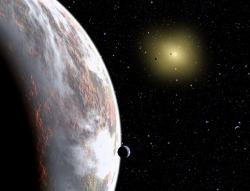Our home planet has been often described in glowing, nurturing terms. A cradle for life, right in the goldilocks zone. But our planet is actually right on the edge of habitability. If it were any smaller, and a little less massive, plate tectonics might never have gotten started. It turns out, life needs plate tectonics.
Astronomers at the Harvard-Smithsonian Center for Astrophysics announced their research today at the Winter meeting of the American Astronomical Society. According to the team, plate tectonics only really get going when a planet gathers enough mass. And the Earth has just barely enough mass to enjoy plate tectonics.
“Plate tectonics are essential to life as we know it,” said Diana Valencia of Harvard University. “Our calculations show that bigger is better when it comes to the habitability of rocky planets.”
[1]
Also from the Bad Astronomer:
You need to look at the statistics, and not by coincidence the United States Geological Survey provides them. When you look at the chart, you see that there is 1 quake per year somewhere on Earth that’s magnitude 8 or more. There are 15 between 7.0 and 7.9 every year, or on average about one every three weeks. Mag 6? 134 per year, or 2-3 per week. Mag 5: 1300 per year, or about 4 per day.
Right away, you can see that there are going to be decent-sized earthquakes somewhere on Earth all the time. And while on average you get mag 7 quake every few weeks, in reality the distribution is random. Getting two of them within a few days of each other is not only not surprising, statistically speaking it’s expected!
[2]

No comments:
Post a Comment